From the Editor: Romancing the Bone –
Unreasonable notions and unrealistic expectations
Kevin Walton Memorial Lecture
QTC’s Community Consultation Tour
An Examination of Traditional Knowledge:
The Case of the Inuit Sled Dog, Part 3
'The Hunt'
OP Nunalivut 10
CAAT Returns to Baker Lake
New to the Crew: Introducing Adult ISDs to Your Kennel
IMHO: Some Things Never Change
Navigating This Site
Index of articles by subject
Index of back issues by volume number
Search The Fan Hitch
Articles to download and print
Ordering Ken MacRury's Thesis
Our comprehensive list of resources
Talk to The Fan Hitch
The Fan Hitch home page
ISDI home page
Editor-in-Chief: Sue Hamilton
Webmaster: Mark Hamilton
Print Edition: Imaged and distributed by the IPL students of the Ulluriaq School, Kangiqsualujjuaq, Nunavik
The Fan Hitch,
Journal of the Inuit Sled Dog International,
is published four times a year. It is
available at no cost online at:
https://thefanhitch.org.
Print subscriptions: in Canada $20.00, in USA $23.00, elsewhere $32.00 per year, postage included. All prices are in Canadian dollars. Make checks payable in Canadian dollars only to "Mark Brazeau", and send to Mark Brazeau, Box 151 Kangiqsualujjuaq QC J0M 1N0 Canada. (Back issues are also available. Contact Sue Hamilton.)
The Fan Hitch welcomes your letters, stories, comments and suggestions. The editorial staff reserves the right to edit submissions used for publication.
Contents of The Fan Hitch are protected by international copyright laws. No photo, drawing or text may be reproduced in any form without written consent. Webmasters please note: written consent is necessary before linking this site to yours! Please forward requests to Sue Hamilton, 55 Town Line Rd., Harwinton, Connecticut 06791, USA or mail@thefanhitch.org
Print subscriptions: in Canada $20.00, in USA $23.00, elsewhere $32.00 per year, postage included. All prices are in Canadian dollars. Make checks payable in Canadian dollars only to "Mark Brazeau", and send to Mark Brazeau, Box 151 Kangiqsualujjuaq QC J0M 1N0 Canada. (Back issues are also available. Contact Sue Hamilton.)
The Fan Hitch welcomes your letters, stories, comments and suggestions. The editorial staff reserves the right to edit submissions used for publication.
Contents of The Fan Hitch are protected by international copyright laws. No photo, drawing or text may be reproduced in any form without written consent. Webmasters please note: written consent is necessary before linking this site to yours! Please forward requests to Sue Hamilton, 55 Town Line Rd., Harwinton, Connecticut 06791, USA or mail@thefanhitch.org
The Inuit Sled Dog International
The Inuit Sled Dog International (ISDI) is a consortium of enthusiasts whose goal is the preservation of this ancient arctic breed in its purest form as a working dog. The ISDI's efforts are concentrated on restoring the pure Inuit Dog to its native habitat. The ISDI's coordinators welcome to your comments and questions.
ISDI Coordinator Canada:
Geneviève Montcombroux, Box 206, Inwood, MB R0C 1P0; gmontcombroux@gmail.com
ISDI Coordinator USA:
Sue Hamilton, 55 Town Line Road, Harwinton, CT 06791, mail@thefanhitch.org
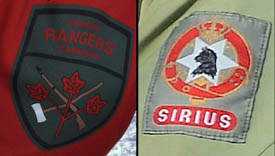
OP Nunalivut 10
The Canadian military's 2010 Operation Nunalivut or OP Nunalivut 101 (Nunalivut is Inuktitut for "land that is ours") began on April 6th and ended April 26th. The Canadian Rangers invited Greenland's renown Sirius Dog Sledge Patrol2, a division of the Danish military, to join the Rangers on this year's maneuvers.
What follows is a transcription of an April 23 satellite phone conversation with Captain Neal Whitman, Deputy Commander of 1 Canadian Ranger Patrol Group and Sergeant First Class Jens Bonde, Chief of Training for the Sirius Dog Sledge Patrol. The interview was conducted by Sue Hamilton, editor of The Fan Hitch. At the time of this interview, these men were in Alert, the Canadian Forces Station, on Ellesmere Island in the Canadian High Arctic, located at Latitude: 82° 28' 60 N, Longitude: 62° 15' 0 W, just 522 miles (840 km) from the geographic North Pole.
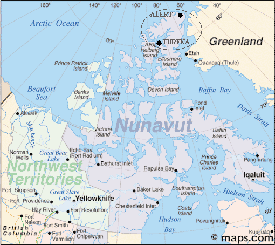
NW: Good afternoon. It's about -15 C (5F) right now, which is quite mild for up here.
JB: Hello, this is Jens Bonde speaking.
SH: Hi. Thank you so much for your time. I really appreciate it.
JB: It's no problem.
SH: Sergeant Bonde, how many men and dog teams came to Canada?
JB: We have brought over our Sled Team Three and it consists of two patrol members and thirteen dogs and all the equipment. I am here as a liaison officer. And I am also a former Sirius Patrol man, having done two years of patrolling over in Greenland.
SH: Captain Whitman, what geographical area and how many miles did you cover?
NW: For this exercise we covered all of the northern side of Ellesmere Island from the east to the west end and approximately fifty nautical miles to the north – about sixty to seventy normal miles. From east to west, the entire area would be around five hundred miles.

Sergeant First Class Jens Bonde (left) and Sergeant Morten Gormsen,
both with the Danish military's Sirius Dog Sledge patrol,
transport one of their dogs for loading into a Canadian Forces Twin Otter
during Operation NUNALIVUT 10.
Photo: Corporal Shilo Adamson; Canadian Forces
Combat Camera: Department of National Defence
JB: It's the same you know. Greenland being only a hundred kilometers away, it's the same area. We patrol in a very large area of Greenland so we've got all kinds of terrain, very steep cliffs and a just little bit of plains, but not so much. It varies a lot, so we are able to do everything and mainly we go on the ice. So it is the same up here.
SH: So basically you're saying that there's no difference in traveling in Canada or Greenland.
JB: No difference.
SH: Captain Whitman, I am very curious to know why the Sirius Patrol was invited to join the Canadian Rangers on OP Nunalivut 10.
NW: This really dates back to last year when our commander, Brigadier General Millar, paid a visit to the Sirius Patrol in Greenland just to see what it is that they do. As you can understand, between two friendly NATO countries we certainly share an interest in safety and security in the arctic environment. So for us it was just the idea of exchanging skill sets because obviously they do things a little bit differently than we do. It seemed like a good opportunity for us to get to know each other a bit and figure out the pros and cons of different ways of doing business and learn from each other.

Preparing the Serius Patrol sledge.
Photo: Sgt. Bruno Turcotte; Canadian Forces
Combat Camera: Department of National Defence
JB: There have been some changes. We now have better equipment so there are more places we can go, but weather-wise you're thinking that has had consequences. We have had to re-route and make some of our timings a little bit different in some areas of Greenland.
SH: That is not unexpected, I would imagine.
JB: Yeah, probably not but it goes forth and back. In some years the ice is laying in certain ways and other times it doesn't. Sometimes it's good and sometimes it's bad. So it varies.
SH: Why is it that the Danish military still feels that the use of dog team patrols is superior to using airplanes or snowmachines?
JB: It's a little bit hard but it is very simple and it takes a few men to run an operation like this. And it has been tested for sixty years now so it works. That's why we keep on doing it. With just two men when we're traveling with dogs, if we have problems out in the field, if one dog breaks down, we can still move. Or if a sled breaks down you can use four millimeters thick nylon cord to fix it and you can go on. So we can always be going, not having to depend on oil for an engine and all that sort of thing. The dogs still keep on running. Even if two dogs are injured we can still go on.
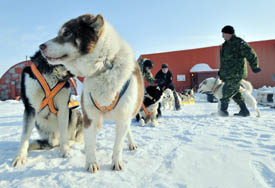
Chief Petty Officer 2nd class Glenn Parsons,
Camp Sergeant-Major of Operation NUNALIVUT 10,
assists the Danish military’s Sirius Dog Sledge patrol in the set-
up of their team in preparation for a familiarization patrol around CFS Alert.
Photo: Corporal Shilo Adamson; Canadian Forces Combat Camera;
Department of National Defence
JB: Yes, it works. In those conditions we are working under we find that the dogs are good for our kind of use on that patrol. There are many ways of doing things, but we have built our model and keep on doing that. But still you have to be able to learn from each other and see where you can make some progress. So we always have to be open minded. But we have tested the dogs now for sixty years and they work.
SH: Gentlemen, I don't know if you got a chance to read the letter of introduction I emailed up to each of you this morning which explains my interest in OP Nunalivut 10. Part of it is to do this interview for The Fan Hitch and part of it is because I am trying to encourage interest in having the Canadian Rangers develop something like the Sirius Patrol in Greenland as a way to establish a future for the Inuit Dog. I just wanted you to know.
NW: Understood.
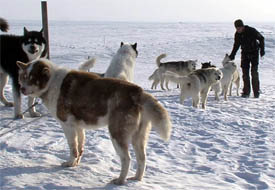
Photo: Sgt. Bruno Turcotte; Canadian Forces
Combat Camera: Department of National Defence
NW: That wouldn't really fall into the type of mandate that we have. The easiest way I can answer that is that the Canadian Rangers operate within the communities and the framework of transportation and movement that those communities use. So we use anything that the people in the communities are willing to use. And to be honest with you, we actually do have the capability to employ dog sleds on our patrol and we sometimes even employ horses on patrol. So it's really just a matter of what the folks in the community want to use. I looked through your information. It's all good stuff but as I said we work with the communities and whatever capabilities they develop we're there with them to work together.
SH: Sergeant Bonde, have there been any veterinary health issues with the dogs so far in Canada?
JB: The operation is still ongoing. But so far we have not had any issues with the dogs.
SH: That's good to hear. I guess the same thing applies when you're patrolling in Greenland. What happens if there is a problem?
JB: We have had a good amount of training back in Demark. The patrol candidates already have to have high qualifications when they're selected. Then they have seven months of training back home in Denmark and that is through a veterinarian program where they have good abilities in that. We have a veterinarian related to our patrol so if we have any questions we can call our veterinarian and he will guide us from there. So it is just normal standard procedure whether it is in Greenland or over here.
SH: So you have coverage at any distance.
JB: Yes, and we are carrying our own medicines and all that stuff so we are well prepared if we are on our own patrol or if we are over here.
SH: Did you bring your own dog food?
JB: Yeah, we are self sufficient while we are over here.
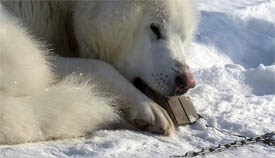
Eating his pemmican meal
Photo: Sgt. Bruno Turcotte; Canadian Forces
Combat Camera: Department of National Defence
JB: The dogs eat pemmican.
SH: And not commercial dog food?
JB: No, we feed pemmican. We have been using it for quite a bit of time.
SH: Captain Whitman, did any of the Canadian Rangers get to have hands on experience with the dog teams?
NW: Yeah, absolutely! In fact just the other day when we were out, a couple of our female Canadian Rangers took the dogs and went on a ten kilometer trip while the Danes got on the Rangers' snowmobiles! We're doing all kinds of patrolling together so it's been really good to exchange not just the sledding experience but also the skills that they have developed for working in the Greenland environment; and back and forth in terms of type of equipment and shelter as well as the sleds of course.
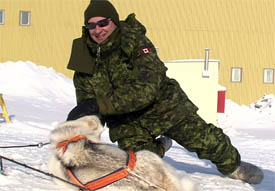
A Canadian Ranger spends a little time with one of the Sirius Patrol dogs.
Photo: Sgt. Bruno Turcotte; Canadian Forces Combat Camera:
Department of National Defence
NW: I don't know. Obviously it's a point of interest for them. There is a very unique capability that works very well for the Danish concept of operations where they're patrolling along the north eastern coast of Greenland in a very isolated environment. In our context it gets a little bit different though because our area of operations is a lot more heavily populated really than the areas that the Sirius Patrol operates in. We operate directly with the aboriginal communities. Fifty-eight different communities participate in the program and a total of sixteen hundred Rangers, which is quite different from the twelve that participate in the Sirius Patrol. For our purposes, again we just choose whatever the community wants to use to get out on the land. If they want to use dog sleds then we can support that and if they want to use snowmachines we can support that. So for us it's really tied in to what the community wants to do and what they feel is the way to get around.
SH: Gentlemen, is there anything else you'd like to comment on regarding this joint operation of the Canadian Rangers and the Sirius Patrol?
JB: I admire the Rangers a lot because they are living on the land and they have experience that we cannot have have. I'm just a college boy from Denmark. I haven't been living my whole life in an arctic area. While I have what it takes and have had a good arctic experience, the Rangers have had it for their whole lives so they can do a lot more than I'm ever going to learn. So I have a great admiration for the Rangers and we can learn a lot from them.
NW: It has been an absolutely fantastic opportunity to work with the Sirius team and learn about them and the way that they do business and I am awed by the way they operate. Any college kid that can leave Denmark and go for twenty-six months on his own just living with one other fellow and a pack of thirteen dogs earns my respect! They are very gifted on the land. It is a capability that certainly has a lot of value when you're doing isolated patrolling and certainly it's something that we, too, would like to not see leave the northern area because it's part of our culture and heritage so we respect it immensely. And whatever we can we will of course support within the communities…that means transportation, obviously.
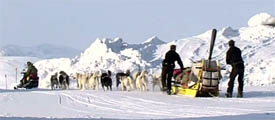
Canadian Rangers and the Sirius Patrol head out on joint exercises.
Photo: Sgt. Bruno Turcotte; Canadian Forces Combat Camera:
Department of National Defence
It has been an honor to be able to chat with you two. Thank you so much for your time.
1 Operation NUNALIVUT 10 is one of three joint operations conducted annually by the Canadian Forces in Canada's North. It employs the unique capabilities of the Canadian Rangers in support of Joint Task Force North (JTFN) operations in the extreme environment of the high Artic. The operation ran from 6-30 April 2010 out of Alert, Canada's most Northerly permanently inhabited location.
2 The Danish SIRIUS patrol is a unique Danish navy unit, which conducts long-range reconnaissance patrolling and enforces Danish sovereignty in Northern and Eastern Greenland. Unlike other military units, SIRIUS is not expected to engage in combat operations. Its purpose is solely to maintain Danish sovereignty and police the area of responsibility.
The Fan Hitch wishes to thank members of the Pubic Affairs Headquarters of the Canadian National Defence: Matthew Lindsey, Jennifer Wright and Lt. Jill Strelieff for facilitating this interview. The Fan Hitch also wishes to express its gratitude to Captain Neal Whitman and Sergeant First Class Jens Bonde for their time, patience and participation.